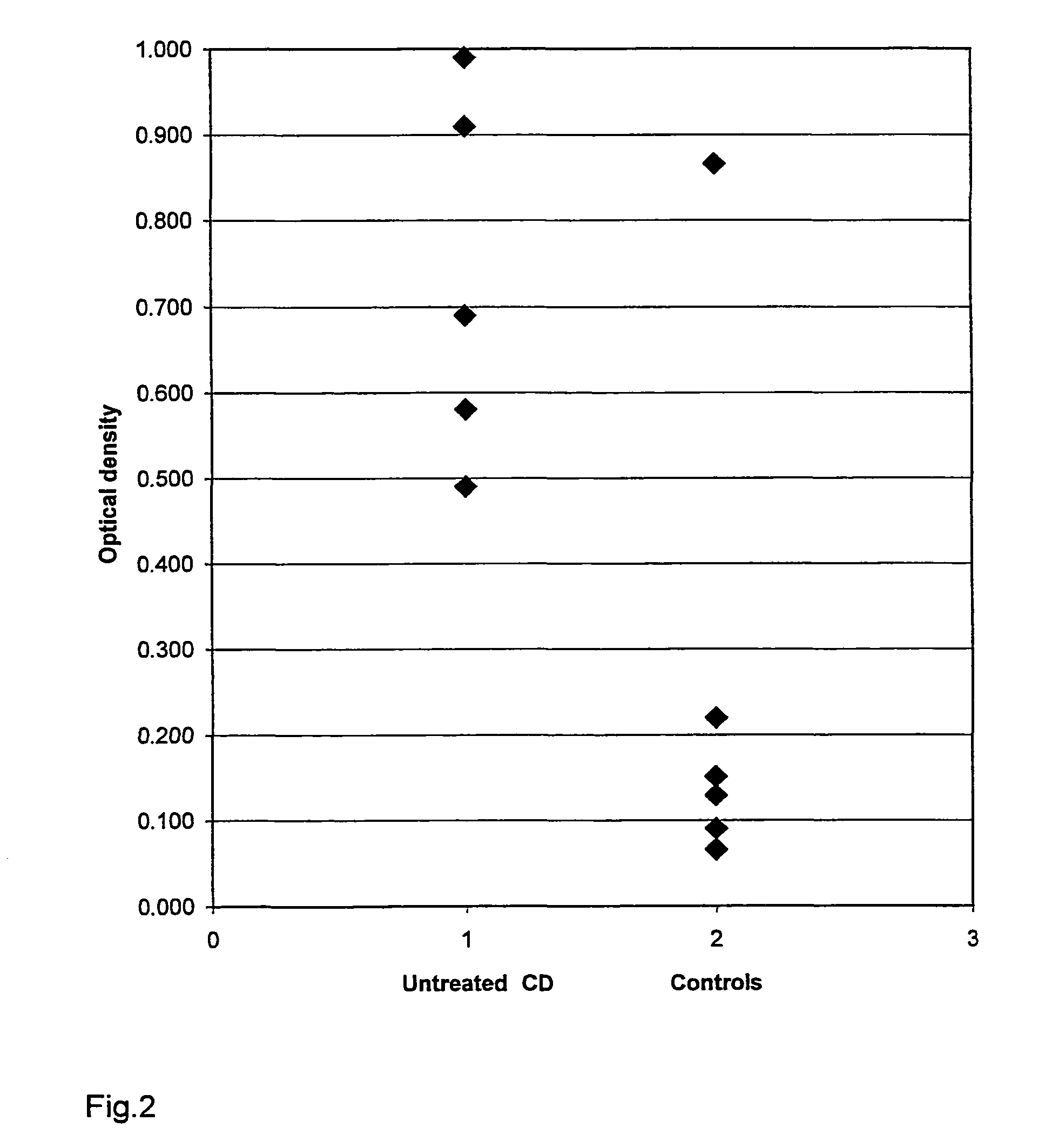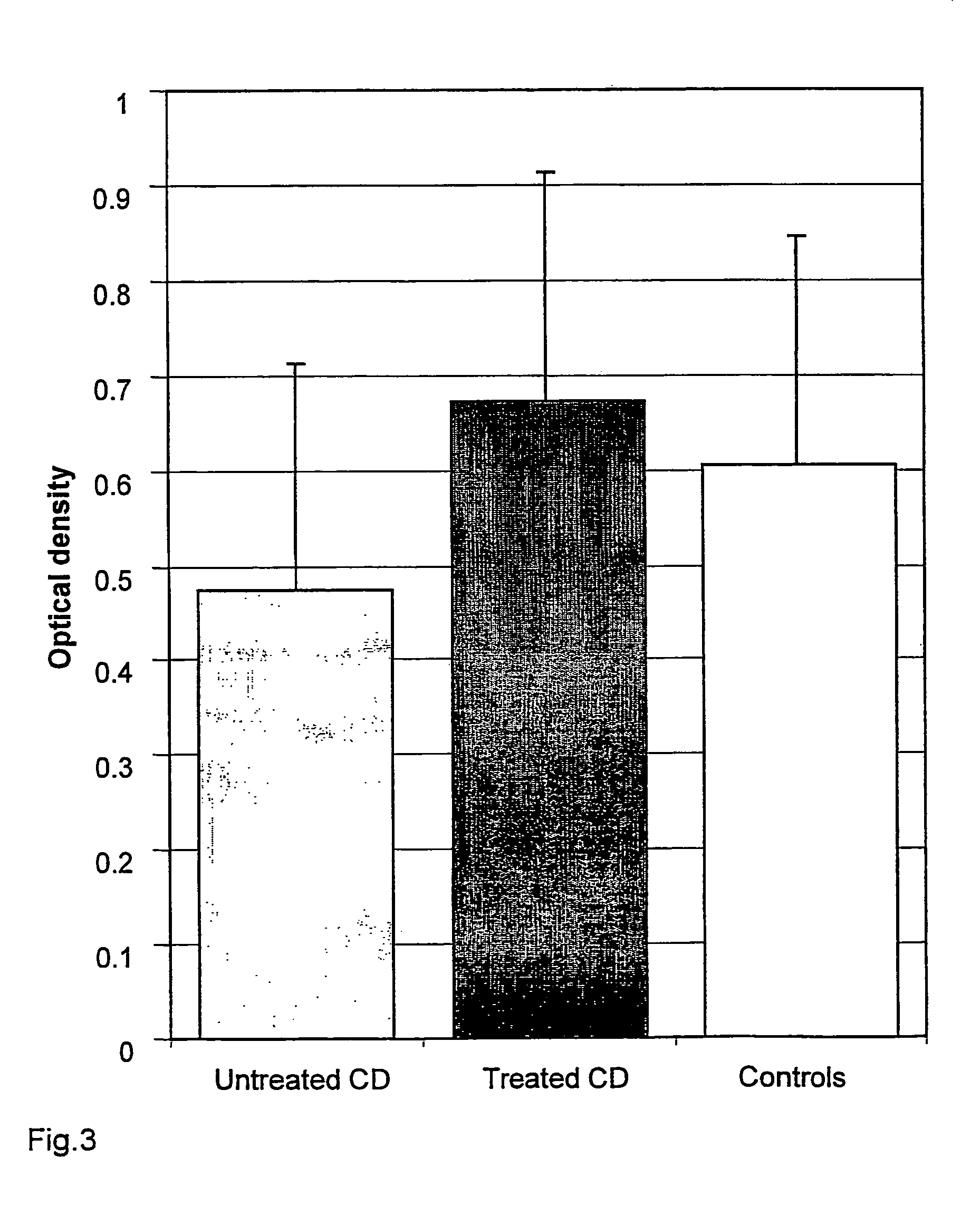Method and means for detecting gluten-induced diseases
a technology of gluten-induced diseases and methods, applied in the field of diagnosis, screening and follow-up of diseases, can solve the problems of untreated celiac disease patients, increased risk of malignancies and small bowel lymphoma, biopsy is an invasive diagnostic tool, and is unsuitable for screening purposes, and it is difficult to maintain the correct folding of enzymes
- Summary
- Abstract
- Description
- Claims
- Application Information
AI Technical Summary
Benefits of technology
Problems solved by technology
Method used
Image
Examples
example 1
[0027]Materials and Methods
[0028]Patients
[0029]Patient samples were collected at the Heim Pal Children's Hospital, Budapest, from patients attending jejunal biopsy for the suspicion of celiac disease (CD) or dermatitis herpetiformis (DH) as well from treated patients diagnosed earlier with these diseases. CD was diagnosed according to the current criteria of the European Society of Paediatric Gastroenterology, Hepatology, and Nutrition, comprising the demonstation of jejunal villous atrophy in histology and a clear clinical improvement on a gluten-free diet as well as the exclusion of other enteropathies. DH was diagnosed with skin biopsy direct immunoflurescent study by the presence of granular IgA deposits in the dermal papillae of the uninvolved skin adjacent to the visible skin lesions. In the first experiment samples from 84 gluten-sensitive patients (51 untreated, including 5 untreated DH; 6 latent, 27 on a gluten-free diet) with a median age of 4.7 years (range: 1-31), and fr...
example 2
Use of Alternative Capture Proteins
[0061]It was tested whether other proteins known to be able to bind to plasma fibronectin would also be suitable to capture endogeneous fibronectin-transglutaminase-celiac patient autoantibody complexes found in the hemolysed patient samples.
[0062]Therefore, in additional experiments, ELISA plates were coated with either heparin (Noparin 5000 lU / ml, Novo Nordisk A / S, Denmark, diluted 1:500), laminin (Upstate, Lake Placid, N.Y., diluted 1:120, 12.5 ug / ml), collagen I (prepared from rat tail tendons according to Halttunen at al. Gastroenterology 1996;111:1252-1262, diluted 1:20, 80 ug / ml) or with 0.025-0.05% gelatin (Rousselot, Paris, France) dissolved in 0.03M bicarbonate buffer, pH 9.6. The further steps of the tests were carried out as in the whole blood test with human anti-transglutaminase IgG capture antibodies as described in Example 1.
[0063]The results are set forth in FIG. 6. Heparin-coated plates did not give specific positivity with celiac...
example 3
Detection of IgA Deficient Celiac Patients
[0065]The use of gelatin as a capture compound also enabled the measurement of captured antigen-autoantibody complexes from whole blood samples of IgA deficient celiac patients, because this capture protein did not interfere with the detection of transglutaminase-autoantibody complexes that might contain only IgG and but not IgA.
[0066]Therefore, the whole blood test with gelatin capture also was performed with an end-reaction that detects IgG class human antibodies bound to the plate using monoclonal antibodies against human IgG (from Pharmacia's Gluten EIA kit) and anti-mouse peroxidase-conjugated rabbit antibodies (DAKO). With this setting, the blood samples obtained from IgA deficient patients with active celiac disease (n=8) tested highly positive (mean optical density 0.824±0.284) while the mean optical density of the controls in the IgG detection was 0.118±0.053.
PUM
 Login to View More
Login to View More Abstract
Description
Claims
Application Information
 Login to View More
Login to View More - R&D
- Intellectual Property
- Life Sciences
- Materials
- Tech Scout
- Unparalleled Data Quality
- Higher Quality Content
- 60% Fewer Hallucinations
Browse by: Latest US Patents, China's latest patents, Technical Efficacy Thesaurus, Application Domain, Technology Topic, Popular Technical Reports.
© 2025 PatSnap. All rights reserved.Legal|Privacy policy|Modern Slavery Act Transparency Statement|Sitemap|About US| Contact US: help@patsnap.com



